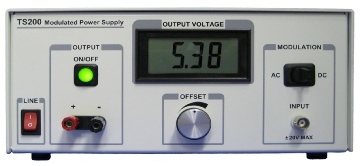








Instruments For Testing Your Innovations


IRVINE, California, July 18, 2011 – Accel Instruments introduces TS200 Modulated Power Supply for general laboratory applications.
The TS200 Modulated Power Supply is a unique test instrument for many test and measurement applications such as waveform generator amplifier, transient response test, LDO PSRR measurement, battery simulator, op amp CMRR measurement, high current amplifier, lab amplifier, and much more. Unlike most power amplifiers on the market, the TS200 output current up to 3.5A is available. Higher current can be obtained by parallel connecting two or more TS200.
The modulated power supply is designed for bench test and measurement. It can output DC or AC voltage or both. For example, it can output a 3.3V DC voltage with a 300mVpp AC sinewave riding on top of it. The TS200 features a modulation input to modulate the output to produce any desired waveform.
High Current Amplifier
TS200 is also great for high current amplifier for driving heavy loads such as Helmholtz coil, low resistance load, and piezoelectric devices. The TS200 high power amplifier can output up to 3.5A. As a function generator amplifier, it takes AC or DC input from a generator and amplify the waveform by a factor of 10. TS200 is also perfect for high current pulse amplifier and lab amp.
Battery Simulator
TS200 modulated power supply can source or sink current as a battery would. For that reason it can be use as a battery simulator. The TS200 has an adjustable DC output voltage knob that can easily emulate battery voltage changes. Thus it is great for battery charger testing such as those in battery operated portable electronic systems.
A battery simulator is a measuring instrument that simulates most of the important battery characteristics. Such characteristics include current sinking, source power, current, and voltage. A battery simulator provides the needed current and voltage to the portable system. Usually a battery simulator will replace the battery inside a mobile system for testing purpose. The battery simulator enables design engineers to easily and comprehensively test these mobile devices. It is required to thoroughly test the product either during product design and development and production testing.
Charger circuit that charges the battery is included in most portable devices. The charger circuitry has to be fully and thoroughly tested to ensure it meets all of the specs and safely charges the battery. From empty battery to full, a charging cycle often needs a few hours to complete. Therefore it needs several hours to test a charging cycle. A complete charging cycle test can be finished in just a few seconds when the battery is replaced with a battery simulator. Likewise, it could take a few days to drain an actual battery in a handheld system. Conversely, a battery simulator can easily emulate an empty battery with a touch of button. While the battery is simulated and "charging", test engineers can observe how the system and charger behave as the “battery” is depleted. Instead of waiting hours to test a real battery, a battery simulator can quickly tests the device to make certain it meets all of the specifications in just seconds. Additionally, a battery simulator can easily emulate an overcharge battery or a completely drained battery (0V), both of which cases are not easy to do with an actual battery.
Medium-
PSRR Measurement
TS200 is perfect for PSRR (power supply rejection ratio) measurement. PSRR is usually tested for amplifiers, LDO voltage regulators, RF components, etc. TS200 is especially powerful for LDO power rejection testing while at high output current. Previous LDO PSRR test methods such as inductor coupled is unable to support low frequency and high load current (i.e. >1A). Op-
In short, the TS200 is intuited and simple use. It is designed for many bench testing applications that includes battery simulator, arbitrary waveform generator amplifier, CMRR and PSRR measurement, line transient testing, Helmholtz coils amplifier, and piezoelectric driver.
About Accel Instruments
Accel instruments designs, develops, manufactures and markets electronic instruments for the specialized needs of electronics bench testing and research and development. We specialize in power electronic test and measurement such as voltage regulators, battery simulation, waveform amplifier, and more. Additional information about Accel instruments is available at www.accelinstruments.com.
Contact Information
Accel Instruments
4521 Campus Dr. STE 254
Irvine, CA 92612 USA
Accel Instruments Introduced TS200 Modulated Power Supply




